| December 21st, 2003 Generally, this is the time of the year when we all once again hear the familiar tale of the Three Wise Men. Well, no disrespect meant, but you won't be hearing their story from me here today. Instead, as part of my own modest celebration of the season, I'd like to instead share a little with you about ANOTHER, unfairly neglected wise man--namely, master cartoonist, Al Wiseman! |
|
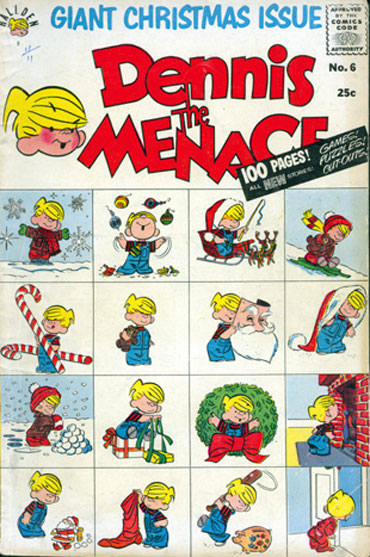 |
|
| You've all heard of "Dennis the Menace",
right? When Hank Ketcham's syndicated gag
panel debuted in the nation's newspapers
back in 1951, it was the very definition
of an overnight success story. The mischievous--and
perennial--five year old's immense popularity
soon demanded that a comic book series be
developed, so to produce the words and pictures
for this new enterprise, Ketcham enlisted
the aid of writer Fred Toole and artist Wiseman,
luring both old friends away from lucrative
jobs in the advertising field. When, as legend
has it (as well as the text feature found
on the inside back cover of the May, 1960
issue of DENNIS THE MENACE--number 42-- that
is not only my primary source for this information,
but the two photos included over yonder as
well), at a time when top titles sold somewhere
between 50 and 60 percent of their total
copies printed, the very first Dennis comic
in 1953 sold out almost it's entire print
run!! Yup, you read that right--an almost
astonishing 100 percent sell-through! No
wonder Fred and Al left their jobs at the
agency soon after the sales figures came
in, and devoted most of the following decade
towards making the regular DENNIS THE MENACE
title--and it's various spin-offs--among
the very best comic books ever produced,
bar none! That's ME talking now, not a paraphrase of the rosy colored picture painted by that undoubtedly biased promo page from 1960. I've long felt Toole and Wiseman's long tenure on the popular title measures up to just about anything else produced in the field's first quarter century. But while John Stanley and Irving Tripp's LITTLE LULU has long had a vocal core of influential admirers--and I wholeheartedly count myself in that thriving number, except for maybe the "influential" part--and the reputation of another of my all-time favorites, Bob Bolling's LITTLE ARCHIE, is gaining momentum with critics every day, the equally wonderful--but subtlety different--work of the DENNIS THE MENACE team continues to be mostly overlooked. Why is this? |
|
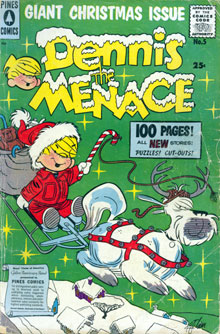 |
Well, perhaps in the case of Lulu, I'd venture it has something to do with the long, long ago cessation of the gag panel produced by creator Marge Henderson Buell, and as that inexorably faded from the culture's collective memory, the superior--and more accessible--comic book stuck in the public's mind in it's stead. As for Little Archie--a concept that, ironically, owes it's very existence to Dennis's initial massive success--I believe it was Bolling's uniquely idiosyncratic take on the almost generic Archie cast of characters that has made his fine work worthy of remembering some five decades after the fact. |
| But Toole and Wiseman's Dennis? Unlike the other two great kid strips mentioned above, the core character's creator didn't quietly fade into the background as the years wore on. In fact, if anything, Hank Ketcham seemed to gleefully court the celebrity his pint-sized pest bestowed upon him, as he skillfully guided his brain-child through various media configurations--television, cartoons, live-action films, books, all sorts of merchandise--while still maintaining a noteworthy presence in the cartoon pages of an impressive number of the nation's newspapers. To the public, then, Hank Ketcham IS Dennis the Menace--even now, several years after his death. And it's my additional theory that, with such a glut of Dennis product spewing out over the past five decades, the comics cognoscenti have deemed any property THAT successful--especially one dealing with kids and clearly aimed at the middle class--to be unworthy of their elite attention, and have given scant consideration to the comics, now long gone, wrongfully assuming them to be just another small piece of a past marketing phenomenon. But they'd be wrong, because these really ARE brilliantly produced comics... | |
| I trust you're all familiar with the basic premise--a five year old's innocent yet non-stop rambunctious behavior makes life for his harried parents one never-ending bout of embarrassment, alternating with exhaustion. Works beautifully for a single panel gag, but just try hanging story after story on that concept and making it work. Well, Toole and Wiseman did--and repeatedly. As with all good comics, the exemplary art--which we'll get to later--had tremendously strong underpinnings provided by Fred Toole's farcical yet still realistic scripts. While the writing started out in a rather broad manner in the earliest issues, as time went on, it quickly came to adhere to a far more recognizable reality than any other found contemporaneously in the field. Unlike both Tubby and Little Archie, there were no friendly Martians visiting Dennis and his young pals. Everything that happened in a Dennis story could actually happen to the reader. Oh sure, any number of unlikely coincidences would have to occur to bring certain more outlandish tales to fruition in a real-life setting, but Toole made certain that Dennis's exploits were never completely out of the realm of possibility! | 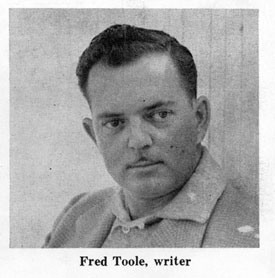 |
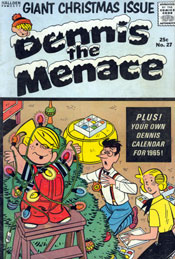 |
And while the primary focus was always on the tiny tornado, parents Henry and Alice Mitchell were never simply portrayed as cardboard foils for the stars lovable antics. Father Henry in particular was oft times effectively used as a top-notch straight man for the little tyke, finding himself in jams that were every bit as laugh-provoking as anything found throughout the entire run of the series! And Henry, try as he might, found himself constantly exasperated by his progeny's well-intentioned--but usually disastrous--escapades. He was always justthisclose to losing his temper big time--and more than once, folks, he actually DID!! Reading these tales as a child, I saw Dennis' dad as a purely comic presence--NOW, after 13 years with my girl Julie, I see him as one of the great sympathetic figures in the history of comics. That poor, poor man--what he had to endure... |
| All this and more came through in Toole's
witty and inventive scripting. He could take
the smallest, the slightest, the most incredibly
mundane of concepts to hang a plot on, and
still make it sing. I'll give you an example
from one of the Christmas specials that I'm
planning to eventually get around to discussing
(Yay! We're ALMOST there!). Coming up with
fresh ideas, year after year, to fill up
nearly a hundred pages with tales revolving
around a single theme couldn't've been easy,
but this underrated scribe somehow managed.
By 1964, you'd've thought all possible angles
would've been exhausted, but not if you read
a nine page gem entitled "Window Wonderland"... Henry comes home from the office with a specially drawn design done for him by an associate, a design that spells out the word "Noel" in fancy Olde English-like lettering. Alice has to clear out, but Dennis eagerly jumps in to help his dad as Henry carefully endeavors to cut out each letter in a different colored piece of bright cellophane, with the plan thereafter being to adhere each letter to the window with black tape (in reverse), finally spraying some artificial snow around it as a finishing touch. Now, this sounds incredibly dry, but the amazing thing is, the story not only works as a sufficiently detailed set of step-by-step how-to instructions (aided, of course, by Wiseman's expertly drawn pictures), but he also manages to wring more than a modicum of truth-based humor out of that simple scenario... |
|
| After all, what parent at one time or another hasn't sat down with their small child, intent on doing a mildly complicated craft project together, only to soon regret the notion when it becomes crystal clear that their potential helper hasn't nearly the patience necessary to complete the deal, instead continuously getting recklessly ahead of things, much to the everlasting chagrin of the adult? Well, that's this story in a nutshell, but it's the manner in which Toole fills his pages with gag after gag that makes such a slight premise so richly entertaining. | 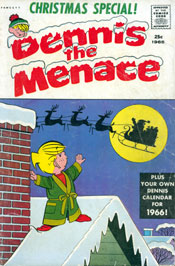 |
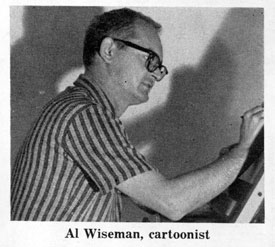
|
Of course, aided by anything less than stellar art, these scripts would lose a fair amount of their impact, but with Al Wiseman as his creative partner, Fred Toole most assuredly didn't have to worry about that. Their combined talents caught the essence of the "modern" fifties far better than any other series published during that transitional era, and compared favorably with the very best of the family-oriented sitcoms broadcast during television's first decades. The meticulously precise linework of Wiseman was responsible for a large portion of this success. While naturally attempting to match Ketcham's stylistic nuances, as the year's wore on, more and more of Wiseman's individuality crept through. Comparing a story from 1953 to one drawn a decade later easily proves this point--the art is still identifiable as the work of the same person, but one whose natural inclination towards a more controlled line has gradually eased out the more fluid strokes associated with the strip's originator. |
| This is by no means a bad thing, mind you,
because, despite a more exacting style, Wiseman
always manages to imbue his characters with
a zestful animation that gracefully sells
each and every one of Toole's cleverly conceived
comedic conceits. And as much as he may've
excelled at bringing the central cast to
life on the page, his unparalleled ability
to create a thoroughly believable environment
for them to frantically frolic in should
in no way be overlooked. According to the
aforementioned 1960 promo page, Wiseman drew
EVERYTHING from life (or failing that, a
really good reference photograph). Every
last detail in a Dennis story looked exactly
right, and I daresay, NO ONE in the world
of post-Code comics drew incidental background
material with the convincing authority Wiseman
did. Quite a few Dennis stories took place
inside their typically furnished suburban
home, and every item--kitchen appliances,
couches, chairs, even TV sets--accurately
reflected those currently being used in actual
homes all across the land. And when Wiseman was called upon to illustrate the Mitchell clans' periodic vacation treks--to Mexico, Washington D.C., Hollywood, and Hawaii--he outdid even himself and produced some of the most authentically gorgeous art EVER--yes, you read that right! I said "ever"--to find it's way into a "lowly" comic book. For these giant specials alone, Toole and Wiseman should be enshrined in some Funnybook Hall of Fame, as their stories wonderfully realized sense of place is unequaled in comics history. |
|
| Which brings us to these Christmas specials. Each one a treasure, they all featured a loosely connected series of sequentially arranged short stories, always culminating with the final episode focusing on Dennis enthusiastically awakening early--usually, VERY early--on Christmas morning. Despite the necessarily formulaic nature of this arrangement, Toole and Wiseman never repeat themselves. Certainly, there are variations on favorite themes--shopping, too many Santas, tree decorating, hiding gifts--but somehow, a fresh angle is always unearthed by this talented pair to make each and every Christmas special, well, SPECIAL! | 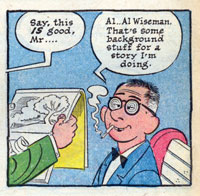 |
| And in keeping with the realistic slant favored by the creators, Santa, despite making numerous appearances over the years, is never even hinted at as being genuine--not even in that corny, "end of story, wink-wink, nudge-nudge, is he or isn't he REALLY the one" manner so familiar to anybody who's ever seen a very special Christmas episode of some generic sitcom over the years. Nope, Santa is ALWAYS either dad, a relative, a store employee, a rich fellow with a beard, Mr. Wilson, or maybe even a cop! This is not to say any of the adults ever come right out and dash the dreams of small children all across the world by stating definitively that there is indeed no Santa (and to any small children reading this right now--what are the odds?--please understand, I'M not saying that either. Honest!), but clearly, the knowledge that ol' St. Nick has a passel of red-suited stand-ins was understood by all save the youngest members of the cast. That, in addition to the occasional nod towards the generally avoided (at least, in comics) religious aspect of this widely celebrated holiday, separated the Dennis Christmas specials from the rest of the pack. (And you might even find our star going off to the little boys room from time to time, ANOTHER function of day-to-day existence generally avoided by, oh, I'd say a good 99.99 percent of the remainder of the books on the stands, if not more...) | |
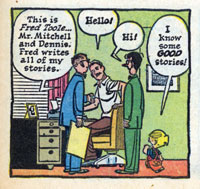 |
For years and years, I'd contentedly read and reread these delightful collections during the waning weeks of December, with the likes of the great Nat King Cole crooning "The Christmas Song", blissfully providing appropriate background music. But unlike the similarly treasured Little Lulu Halloween giants I enthused about a few months back, I did not actually own ANY of the holiday specials pictured hereabouts while I was growing up. Sure, I had plenty of the OTHER Dennis specials released during the early sixties in my possession--the aforementioned vacation issues, whole books co-starring Joey, Margaret, Ruff, and Mr. Wilson, several based on the Jay North television series--but the only Christmas special I ever owned back in the sixties was one drawn by Owen Fitzgerald. |
| Time for a digression within a digression. My earliest copies of DENNIS THE MENACE were supplied in the legendary gratis box of kiddie comics passed on to my dad by a co-worker, undoubtedly the most significant off-hand gift bestowed upon me in my entire misbegotten life, a story I've told time and again, even once in illustrated form. Several issues containing Wiseman art were included--such as the winter-themed number 41--and once I soon after started buying my own comics, I made sure to include every available Dennis publication in amongst my, ahem, "more mature" super-hero-type purchases. But with so many triple-sized editions being released as the success of the TV show apparently upped the demand for Dennis product to an all-time high, something had to give, and that something was, sadly, Al Wiseman's exclusive and total reign over the Dennis comics. Happily, he continued to handle the majority of the ever more frequently issued giants, but suddenly, the regular Dennis title was being drawn by--and pardon me for saying this--a TERRIBLE artist!! Arrgh! | 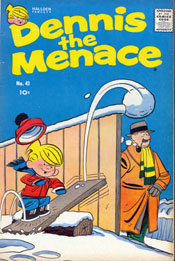 |
| Ranking right up there--or should I say,
DOWN there?--with Ross Andru taking over
for Carmine Infantino on THE FLASH and John
Romita stepping in for Steve Ditko on AMAZING
SPIDER-MAN, I was similarly aghast at this
radically new artistic approach. Whereas
Wiseman was precise and controlled, this
new guy's drawings seemed sloppy and dashed
off with little thought as to the very quality
of the linework. It was only the still enjoyable
writing of Toole, as well an ingrained fondness
for the characters, that kept me coming back.
I somehow missed the handful of Wiseman Christmas
giants issued during the mid-sixties, winding
up with only a single one drawn by this scourge
with a fast and loose brush. At the time,
it was like a getting a piece of coal in
my stocking... For years and years, I had absolutely NO idea who the perpetrator was who had come in and all but ruined Dennis for me. It wasn't until I read something somewhere by the estimable Mark Evanier, championing the work of a long-time cartoonist named Owen Fitzgerald, including the Dennis assignment on a long, impressive list of accomplishments, that I suddenly came to realize just whose work I'd vilified in the remote recesses of my mind for all those years. Subsequently, getting an opportunity to more closely examine a lot of the work he did during the fifties for other publishers, particularly on DC titles like BOB HOPE and other girlie-centric titles, I finally began to appreciate his not-insubstantial talents. Just as I eventually came around to Romita on Spidey, and Andru on most everything else, I came to realize I'd judged Fitzgerald unfairly. He was NOT a horrible artist--anything but. But WAS he the ideal choice to fill in and provide some breathing room for Wiseman? I still don't think so, as their stylistic approaches were just too far apart to be anything but jarring when seen in quick succession. But I DID form a new appreciation for his Alice Mitchell--rorwff!... |
|
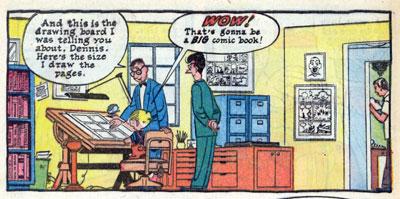 |
|
| It was while perusing the colorful-yet-slowly-decaying
wares found in the dealer's room at a mid-seventies
New York City Comicon that I accidentally
stumbled across these five golden things.
In fact, there was also a handful of other
giant editions I'd never seen before--including
several generic vacation issues that predated
the wildly successful single destination
tomes of later years--as well as a healthy
run of the standard sized Dennis title too.
AND they were all reasonably priced! Well,
never one to spend overmuch for back issues,
I was reluctant to commit all my available
cash to the whole kit and kaboodle, ultimately
choosing instead to buy just the dozen or
so giants that I'd never encountered before,
leaving the rest in their sales boxes. It's
a decision that, yes, has haunted me for
many years--but hey, I was just out of college,
okay, and didn't have the ready finances,
dig? Still, I shoulda grabbed 'em all--y'see,
reading my brand new purchases renewed my
then-latent enthusiasm for the work of Toole
and Wiseman, and I wound up spending the
next several years relentlessly poring over
tiny ads in CBG, searching out as many of
the early Dennis issues as I could find at
fairly cheap prices (including number 30
from 1958, featuring a story where Dennis,
in a manner of speaking, meets his maker(s),
several key panels of which you'll find nearby...).
I never did quite complete my collection,
but I probably wound up with at least two-thirds
of the Wiseman illoed issues (and there's
at least one other Christmas book drawn by
Al that I don't own, though my good friend
and fellow Wiseman fan, Terry Austin, once
lent me his copy to read, which brightened
that particular holiday season immensely,
believe you me!...) The funny thing is, I was deep into my twenties when I picked up these books, already hooked up with my dear wife-to-be, Lynn, and yet I'm as fond of these five publications as I am of anything I read at the impressionable age of eight. Now, that either says a lot about the power of the material contained therein--or about my blatantly stunted maturity!?! Hey, maybe it's a little of both, y'know? But as I casually indicated above, I'm hardly alone in my appreciation of the DENNIS THE MENACE comics team. Besides Terry, I know for a fact such top-notch artists and creators as Bret Blevins, Bill Alger, Walt Simonson, Jim Shooter, Bill Wray, and the Hernandez Brothers hold this work in the highest of esteem as well (and, hey, let's add my old pal Rocco to that list while we're at it, too...). I believe the only thing that's keeping this series from getting the sort of respect it so richly deserves is a vocal and unrelenting champion. I'm not saying I'm that person, but if this heartfelt tribute does anything to nudge things in that direction, I'd be extremely pleased. Too often, aficionados, overly steeped in the fantasy aspect of comics, indiscriminately turn their noses up at material aimed at a younger audience as being essentially worthless, but I'd happily match the Toole/Wiseman material up against the more famous adventure-oriented titles of the period, and save for a few isolated stories here and there, feel confident Dennis would triumph if handed to a non-biased third party to examine. Because, friends, the books really WERE that good!... |
|
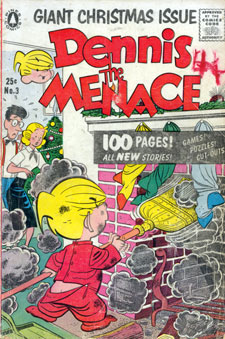 |
A few words about the lettering. It's perhaps the most expressive ever seen in a comic book. Period. Al Wiseman proved to be as superb a calligrapher as he was a cartoonist. The imaginative use of upper case, lower case, and brightly colored display lettering, all within the context of a characters single word balloon, allows for us to "hear" the dialog far more effectively than is possible when merely utilizing a standard approach. The comedy is only intensified when one gets a truer sense of a gags proper line-reading, and the exasperation that comes through when poor put-upon Henry's words blurt out in large, red letters-- contained in a suitably jagged word balloon--can be palpable, and thus, truly hilarious. To paraphrase my soul-mate on "The Simpsons", best lettering ever... |
| As a special holiday treat for you all, I've
happily scanned in a story from the
1964
edition called "Self Service Santa" over at the aptly titled "Stuff I Had
NOTHING To Do With" section of this
very site. It was a tough chore choosing
but one story out of the many fine ones available
to share with you folks, but ultimately,
this is the one I picked. Admittedly, there
were several self-imposed restrictions I
found myself laboring under. First off, I
wanted to showcase some of Wiseman's later,
more meticulous work, as opposed to his earlier,
more Ketcham-like (but still marvelous) material.
Then there was the matter of the actual scanning
itself... Gang, I love ya, one and all, but not quite enough to completely destroy these wonderful comics! Y'see, they all have square-spines, making it all but impossible to get every last detail of a mid-issue tale properly into the scanner without completely squashing the binding flat. So I was pretty much limited to either the first or last story in any given issue, and since the last story, like Christmas morning itself, always boarders on being anti-climactic, I instead elected to go with their opening salvo for '64, featuring a memorable visit to a flummoxed department store Santa. Look especially for the big laugh at Henry's expense at the end of page 5, and his entirely realistic reaction to it atop the very next page. Also, notice how convincing Wiseman makes his setting, always without an excessive usage of meaningless lines. And marvel how the creative use of lettering in "Santa's" balloon in the second to last panel on the next to last page ups that moments humor quotient all that much more. While this tale ends on an atypically happy note for the Mitchell family, those of you unfamiliar with the work of these two talented gentlemen will hopefully nevertheless get a sense of why I'm so sincerely enthusiastic about their work. A final note. One of the thrills of putting yourself out on the Internet is that you just don't know from day to day who might turn up. Well, several days ago, while periodically checking for any fresh entries in my Guest Book, I was surprised--AND extremely excited--to see that, of all people, the late Al Wiseman's son, Jim, had checked in! He had a few gracious words to say about "Petey", my meager--yet personally extremely satisfying--attempt to blend Lee and Ditko's pre-Spider-Man Peter Parker with the vastly attractive style employed by his father on the Dennis comics. As I informed him in a return note--in addition to thanking him for his good wishes--I had just the day before dug out his dad's Christmas classics with the full intention of doing this particular write-up. So, I went on, wait just a bit--I'll tell you exactly what your father's art meant to me over on my web-site! And I'm gonna let everybody else know, too! Well, here it is, Jim. I think by now you can clearly gather that your dad's work meant a whole heckuva lot to me, and I hope I've done him a small measure of justice in my muddled attempts to explain his lasting appeal to those out there who weren't lucky enough to grow up like I did, reading comics featuring his expressive drawings, rendered with that impeccable steady line of his! So, to end things with the words Dennis repeated on the last page of several of these Christmas extravaganzas (mirroring a particularly famous Ketcham cartoon) as he sits among a massive pile of presents, now bereft of their hastily torn off gift-wrapping: |
|
| "Is this ALL?" Yup! At least for now... Merry Christmas everyone! |
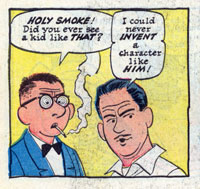 |